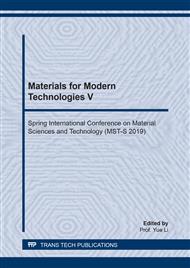p.140
p.148
p.155
p.161
p.167
p.174
p.180
p.194
p.200
Effect of Aramid Fiber Surface State on Properties of Epoxy Resin Composites
Abstract:
The surface state of aramid fiber was modified by coupling agent to characterize the change of the state. The fiber / epoxy resin composites were prepared to study the mechanical and electrical properties and the internal mechanism of how different surface states affect. The results show that, after the treatment with the coupling agent, the surface roughness of the aramid fiber is increased,and the content of Si on the surface reach 5.8%, thus the surface activity is enhanced. At the same time, the treatment makes the properties of composites further improved. When the filling amount of aramid fiber reaches 30 strands, the tensile strength increase by 38.4% due to the coupling agent. In the test of two-layer samples, the breakdown field strength of the composites before and after treatment with coupling agent increased by 15.9% and 20.2%, respectively.Key words: aramid fiber; coupling agent; surface state; mechanical properties; electrical properties
Info:
Periodical:
Pages:
167-173
Citation:
Online since:
June 2019
Authors:
Price:
Сopyright:
© 2019 Trans Tech Publications Ltd. All Rights Reserved
Share:
Citation:


